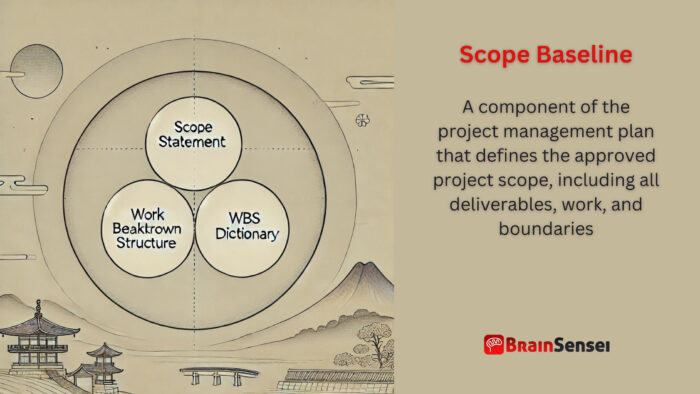
Scope Baseline
What is the Scope Baseline?
The scope baseline is a component of the project management plan that defines the approved project scope, including all deliverables, work, and boundaries. It consists of three key elements: the scope statement, the work breakdown structure (WBS), and the WBS dictionary. The scope baseline is a reference for tracking project progress and managing scope changes.
Key Takeaways
- Establishes the approved scope of a project
- Includes the scope statement, WBS, and WBS dictionary
- Serves as a benchmark to monitor and control project scope
- Helps manage scope changes through formal processes
- Essential for maintaining project focus and avoiding scope creep
Understanding the Scope Baseline
How It Works
The project team meticulously crafts the scope baseline during the planning phase. It becomes the foundation for executing, monitoring, and controlling project work. Project managers use it to assess progress, communicate expectations, and handle change requests, making it a vital part of project management.
Notes
- Changes to the scope baseline require formal change control
- Misaligned scope definitions can cause misunderstandings
- Scope baseline should align with project objectives and stakeholder expectations
- Inaccurate WBS may result in overlooked deliverables
Related Terms
- Project Scope Statement: A detailed description of project deliverables and constraints.
- Work Breakdown Structure (WBS): A hierarchical work decomposition into manageable sections.
- WBS Dictionary: Provides detailed descriptions of each WBS element.
- Scope Creep: Uncontrolled changes or growth in a project’s scope.
- Change Control Process: A formal procedure for managing scope changes.
Examples of Scope Baseline in Different Industries
Construction Industry
In a commercial building project, the scope baseline specifies the number of floors, materials, and structural requirements. The WBS breaks down tasks such as site preparation, foundation work, and interior finishes—the WBS dictionary details specifications like concrete strength and window types. During construction, any scope changes, like adding an extra floor, undergo a formal review to assess the cost and timeline impacts.
The project begins with creating a detailed project scope statement that outlines the objectives, deliverables, and constraints. The scope statement indicates the need for a ten-story office building with a glass facade, energy-efficient systems, and modern amenities. The WBS divides the work into design, procurement, construction, and commissioning phases.
The WBS dictionary provides granular details about each task. For example, it specifies the type of glass used for the facade, the energy standards requirements, and the materials for interior finishes. As the project progresses, regular reviews of the scope baseline help the project team track work and identify deviations.
Midway through construction, the client requested an additional floor to accommodate more office space. The project manager used the scope baseline to evaluate the implications of this change. The WBS helped identify the tasks affected, such as structural modifications and additional materials. The team documented, reviewed, and approved the changes through the change control process to avoid scope creep and ensure the delivery of the new requirements without jeopardizing project success.
Healthcare Industry
The scope baseline defines additional departments and equipment requirements for a hospital expansion project. The WBS identifies equipment installation and staff training tasks, while the dictionary clarifies equipment specifications. When a new MRI machine is requested mid-project, the scope baseline helps evaluate the change’s feasibility and impact.
The hospital board initiated the project to add a new wing with advanced imaging facilities, more patient rooms, and upgraded surgical suites. The project scope statement outlines the goals: increase capacity by 30%, add MRI and CT imaging capabilities, and implement energy-efficient systems. The WBS breaks down tasks into structural work, equipment procurement, installation, and staff training.
The WBS dictionary provides detailed information about the imaging equipment, including power requirements, operational guidelines, and vendor specifications. As work progresses, the project team holds regular scope review meetings to track performance against the baseline.
During installation, a physician requested a new MRI machine with higher resolution capabilities. The project manager assesses the change using the scope baseline (WBS). The WBS helps identify necessary adjustments, such as additional power infrastructure and staff training. The change control process analyzes costs, timeline impacts, and potential risks. The project remains on track despite the mid-project modification by adhering to the baseline.
Telecommunications Industry
A telecom company expanding its network infrastructure uses the scope baseline to outline new tower locations and equipment specifications. The WBS details activities like site acquisition and equipment setup. The WBS dictionary includes technical parameters such as signal frequency. If they need to add a new location, the baseline is a reference to determine the adjustment’s effects.
The company plans to install 50 new cell towers in rural areas to extend its coverage. The project scope statement (WBS) describes objectives such as coverage enhancement, reduced call drop rates, and increased data speeds. The WBS divides tasks into phases: site selection, permitting, equipment procurement, installation, and testing.
The WBS dictionary details each task. For instance, site acquisition requires surveys, legal agreements, and land preparation. Equipment specifications include antenna types, power supply standards, and installation protocols. The baseline becomes a critical tool for monitoring progress and ensuring adherence to initial plans.
As the project advances, the marketing team suggests adding ten more towers to address growing demand. The project manager analyzes the proposal using the baseline. The WBS identifies the impact on procurement, labour, and permitting tasks. They conduct a cost-benefit analysis and present the change to the executive team. The scope baseline is updated upon approval to reflect the new requirements, ensuring that the expansion meets operational goals and budget constraints.
Use Cases of Scope Baseline
United States (IT & Software Development)
A software development firm in California uses a scope baseline to manage a mobile app project. The scope statement specifies features like user authentication and payment integration. The WBS lists development, testing, and deployment tasks, while the dictionary clarifies technical requirements. When marketing proposes new features, the baseline ensures these changes follow formal approval processes.
The team begins with a detailed planning session, documenting the project’s objectives, deliverables, and constraints. The scope statement outlines the app’s functionalities, including secure login, real-time notifications, and payment processing. The WBS breaks these tasks into smaller components: front-end design, back-end development, and user testing.
Throughout development, the project team conducts regular reviews to monitor progress. When the marketing team suggests adding social media integration, the project manager consults the baseline. The WBS identifies affected tasks, such as code adjustments and additional testing. A formal change request is submitted, analyzed, and approved, ensuring controlled scope expansion. Additionally, the team documents lessons learned to refine future project planning.
Germany (Automotive Manufacturing)
An automotive manufacturer in Germany applies a scope baseline for an electric vehicle production project. The scope statement defines performance targets and design elements. The WBS breaks down components like battery systems and chassis assembly. The WBS dictionary describes materials and suppliers. Any proposed design changes undergo structured evaluations to avoid timeline disruptions.
The project starts with a strategic workshop involving engineering, production, and marketing stakeholders. The scope statement specifies targets like extended battery life, aerodynamic efficiency, and safety compliance. The WBS divides the project into design, testing, and production phases.
Midway, the design team suggests enhancing the car’s infotainment system. The project manager references the scope baseline to assess this change. The WBS highlights the impact on hardware, software, and testing tasks. The designers submitted a change request, and the Change Control Board (CCB) approved the modification after thorough analysis. This structured approach ensures the project’s timeline and budget remain intact. Additionally, the team uses performance metrics to evaluate the success of scope changes.
Japan (Robotics Industry)
A robotics company in Japan launches a new industrial robot using a scope baseline (WBS). The baseline defines capabilities, production milestones, and testing protocols. The WBS also outlines hardware and software development tasks and provides component details. The CCB assesses any suggested changes that impact delivery and cost during production.
The initiative begins with a collaborative planning phase involving engineers, product managers, and clients. The scope statement specifies functionalities like precision welding, automated diagnostics, and remote control. The WBS breaks down these tasks into sensor calibration, motor integration, and control software development.
During production, a client requests improved diagnostic features. The project manager evaluates the change’s implications using the baseline. The WBS identifies the necessary software and hardware adjustments. After approval through the change control process, the development team implements the enhancements without derailing the project timeline. Additionally, they use the feedback from this process to improve future project planning and execution.
Best Practices for Using Scope Baseline
To ensure the effective use of the scope baseline, project managers should follow several best practices:
Stakeholder Engagement
Involve key stakeholders early to define and approve the scope. Clear communication ensures everyone understands the project’s goals and boundaries.
Detailed WBS Creation
Develop a comprehensive WBS with clearly defined deliverables, tasks, and responsibilities. Each component should have specific descriptions to prevent misunderstandings.
Regular Scope Reviews
Conduct periodic scope reviews to identify potential deviations early. Regular monitoring helps maintain alignment with project objectives.
Change Control Process
Implement a structured change control process to handle scope modifications. Document and analyze change requests before approving them or implementing them.
Team Collaboration
Foster collaboration between departments to avoid silos and ensure consistent understanding of scope elements.
Training and Documentation
Train team members on the importance of scope management and provide accessible documentation for reference.
Performance Metrics
Use performance metrics and KPIs to track adherence to the scope baseline. Analyze deviations to identify root causes and improve processes.
Lessons Learned
After project completion, conduct a review to document lessons learned regarding scope management. Use these insights to enhance future projects.
Common Mistakes and Issues
Understanding common mistakes and issues associated with the scope baseline is critical for effective project management. Inaccuracies in scope definition, poor communication, and inadequate change control processes can derail even the most meticulously planned projects. Here, we explore some of the most prevalent mistakes and provide insights on how to avoid them.
Incomplete Scope Documentation
One of the most frequent mistakes is incomplete or vague scope documentation. If the project scope statement lacks clarity regarding deliverables, boundaries, and objectives, managing expectations and tracking progress becomes difficult. For example, a construction company once faced delays and cost overruns because the blueprint did not specify the type of materials required for interior finishes. To avoid this, project managers should ensure the scope statement is detailed, precise, and reviewed by all stakeholders.
Neglecting the Work Breakdown Structure (WBS)
The WBS is essential for organizing project work into manageable components. When teams overlook this structure or create one that is too high-level, they can miss tasks, and responsibilities become unclear. A manufacturing firm experienced production delays when it failed to break down the assembly tasks into individual components, confusing work assignments. Regularly reviewing and updating the WBS helps maintain task clarity and accountability.
Lack of Stakeholder Involvement
Inadequate stakeholder engagement during the scope planning phase can result in misunderstandings and misaligned objectives. For instance, a healthcare project implemented a new patient management system without sufficient input from medical staff. As a result, the system lacked critical functionalities, requiring costly post-implementation changes. Engaging stakeholders early and continuously captures their requirements and concerns from the start.
Scope Creep
Scope creep occurs when projects introduce changes without proper evaluation and approval. This issue often arises from a lack of stringent change control processes. For example, a retail company renovating its stores experienced budget overruns when managers added new design elements mid-project without assessing their impact. Establishing a formal change control process helps maintain project boundaries while allowing for justified adjustments.
Miscommunication and Poor Documentation
Clear communication and thorough documentation are fundamental for successful scope management. A software development team once misinterpreted a client’s requirements due to ambiguous documentation, resulting in a product that did not meet expectations. Project managers should implement consistent communication practices, utilize collaboration tools, and maintain updated documentation accessible to all team members.
Overlooking External Factors
External factors such as regulatory changes, market conditions, and technological advancements can impact project scope. An energy company experienced setbacks when new environmental regulations required modifications to its infrastructure project. Regular environmental scans and incorporating contingency plans into the scope baseline can mitigate such risks.
Inadequate Training and Resources
Project teams need appropriate training and resources to follow the scope baseline effectively. A telecommunications company faced operational disruptions when its staff were unfamiliar with the new network equipment specifications. Providing training sessions, resource manuals, and ongoing support helps teams adhere to scope requirements.
Case Study: Consider a large-scale IT project for a financial services firm. The project’s initial scope baseline specified the development of a secure online banking platform with essential features like account management, fund transfers, and bill payments. However, marketing executives requested additional features like personalized dashboards and predictive analytics during development. Without following the change control process, the development team implemented these changes, resulting in missed deadlines, budget overruns, and system performance issues. The company later revised its practices by reinforcing its change management protocols, conducting regular scope reviews, and training staff on the importance of adhering to the baseline.
Conclusion: Avoiding these common mistakes requires proactive planning, ongoing communication, and following the scope baseline. By understanding potential pitfalls and applying best practices, project managers can maintain control over project scope, deliver high-quality results, and achieve stakeholder satisfaction.
Frequently Asked Questions (FAQs)
What is the primary purpose of the scope baseline?
The primary purpose is to define the approved project scope and serve as a reference for tracking performance and managing changes.
What components make up the scope baseline?
The scope baseline consists of the project scope statement, the work breakdown structure (WBS), and the WBS dictionary.
Why is the scope baseline important in project management?
It helps maintain project focus, manage changes, and ensure alignment with project goals and stakeholder expectations.
How can scope creep be avoided?
The project team can mitigate scope creep by establishing a well-defined baseline, conducting regular scope reviews, and following strict change control procedures.
Who is responsible for maintaining the scope baseline?
The project manager is primarily responsible, with input from stakeholders and the project team.
Additional Resources
Preparing for a PMI certification?
- Exam Prep Courses: PMP®, CAPM®, and PMI-ACP®
- Exam Simulators: PMP®, CAPM®, PMI-ACP®, PMI-PBA®, PMI-RMP®, PMI-SP®, PgMP®, and PfMP®
- Professional Development Units (PDUs): 15, 30, and 60 PDU Bundles



